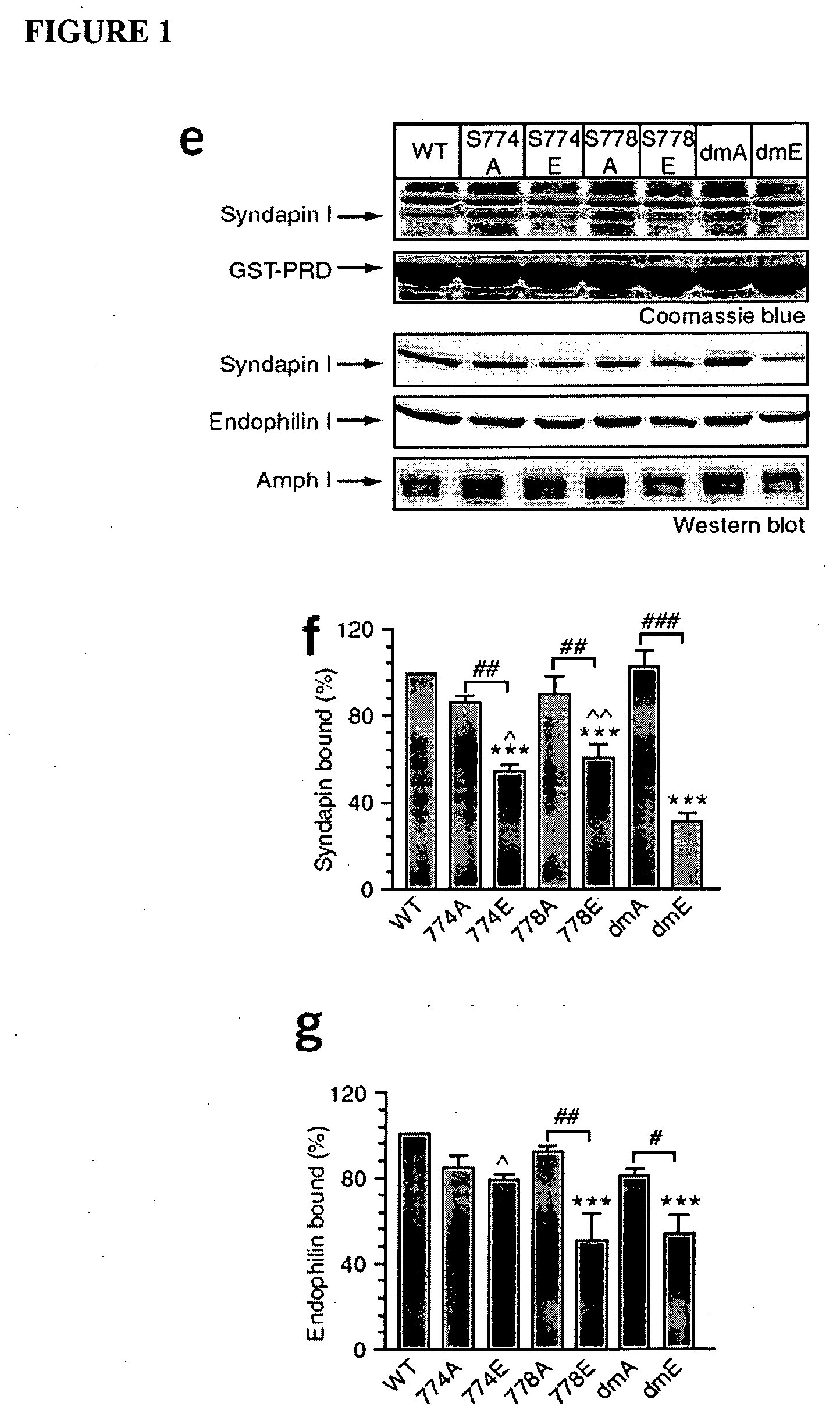Agents for prophylaxis or treatment of neurological related diseases and conditions
a technology for applied in the field of agents for prophylaxis or treatment of neurological related diseases and conditions, can solve problems such as difficult studies and achieve the effect of reducing binding
- Summary
- Abstract
- Description
- Claims
- Application Information
AI Technical Summary
Benefits of technology
Problems solved by technology
Method used
Image
Examples
example 1
Identification of Syndapin I Binding to DynI
1. Materials and Methods
1.1.1 DNA Constructs
[0080]Dynamin I-Green fluorescent protein (rat sequence, Iaa isoform) in pEGFP-N1 was provided by Dr Mark A. McNiven (Mayo Clinic, Minnesota) (Cao et al. 1998). The sequence encoding the dynamin Iaa-PRD (rat, amino acids 746-864) was amplified from this GFP-tagged dynamin Iaa with the oligonucleotides 5′-CGGCGAATTC-AACACGACCACCGTCAGCACGCCC-3′ (SEQ ID No. 14) and 5′-CTGCAGAATT-GCGGCCGCTTAGAGGTCGAAGGGG-3′ (SEQ ID No. 15) and then subcloned into pGEX4T-1 vector (Amersham Biosciences) as previously described (Anggono et al. 2006). Underlining indicates unique restriction sites used for subcloning the amplified cDNA. Dynamin I point mutants were generated using the QuickChange site-directed mutagenesis kit (Stratagene) and were confirmed by DNA sequencing. All GST-fusion proteins were expressed in Escherichia coli and purified using glutathione (GSH)-sepharose beads (Amersham Biosciences) according to...
example 2
Identification of the DynI Binding Sites for Syndapin I and Endophilin I
2.1 Materials and Methods
[0109]Peptides were synthesised by Mimotopes (Clayton, Australia). FM4-64 was purchased from Molecular Probes (Eugene, Oreg.). Tissue culture plastics were from Falcon (Franklin Lakes, N.J.). Penicillin / streptomycin, phosphate buffered salts, foetal calf serum and Minimal Essential Medium (MEM) were obtained from Invitrogen (Carlsbad, Calif.). All other general laboratory chemicals were from Sigma (St. Louis, Mo.) unless otherwise stated.
2.1.1 Antibodies and Western Blots
[0110]Anti-syndapin I, anti-endophilin I and anti-p85 antibodies were obtained from Santa Cruz Biotechnology (Santa Cruz, Calif.). Anti-Grb2 was purchased from Transduction Laboratory (Lexington, Ky.). Anti-amphiphysin monoclonal antibody was from Pietro De Camilli (Yale, New Haven, Conn.). Anti-dynamin I antibody was as previously described (Tan et al. 2003). Protein samples were separated by SDS-PAGE on 10% or 12% acry...
PUM
| Property | Measurement | Unit |
|---|---|---|
| pH | aaaaa | aaaaa |
| length | aaaaa | aaaaa |
| synaptic transmission | aaaaa | aaaaa |
Abstract
Description
Claims
Application Information
 Login to View More
Login to View More - R&D
- Intellectual Property
- Life Sciences
- Materials
- Tech Scout
- Unparalleled Data Quality
- Higher Quality Content
- 60% Fewer Hallucinations
Browse by: Latest US Patents, China's latest patents, Technical Efficacy Thesaurus, Application Domain, Technology Topic, Popular Technical Reports.
© 2025 PatSnap. All rights reserved.Legal|Privacy policy|Modern Slavery Act Transparency Statement|Sitemap|About US| Contact US: help@patsnap.com



